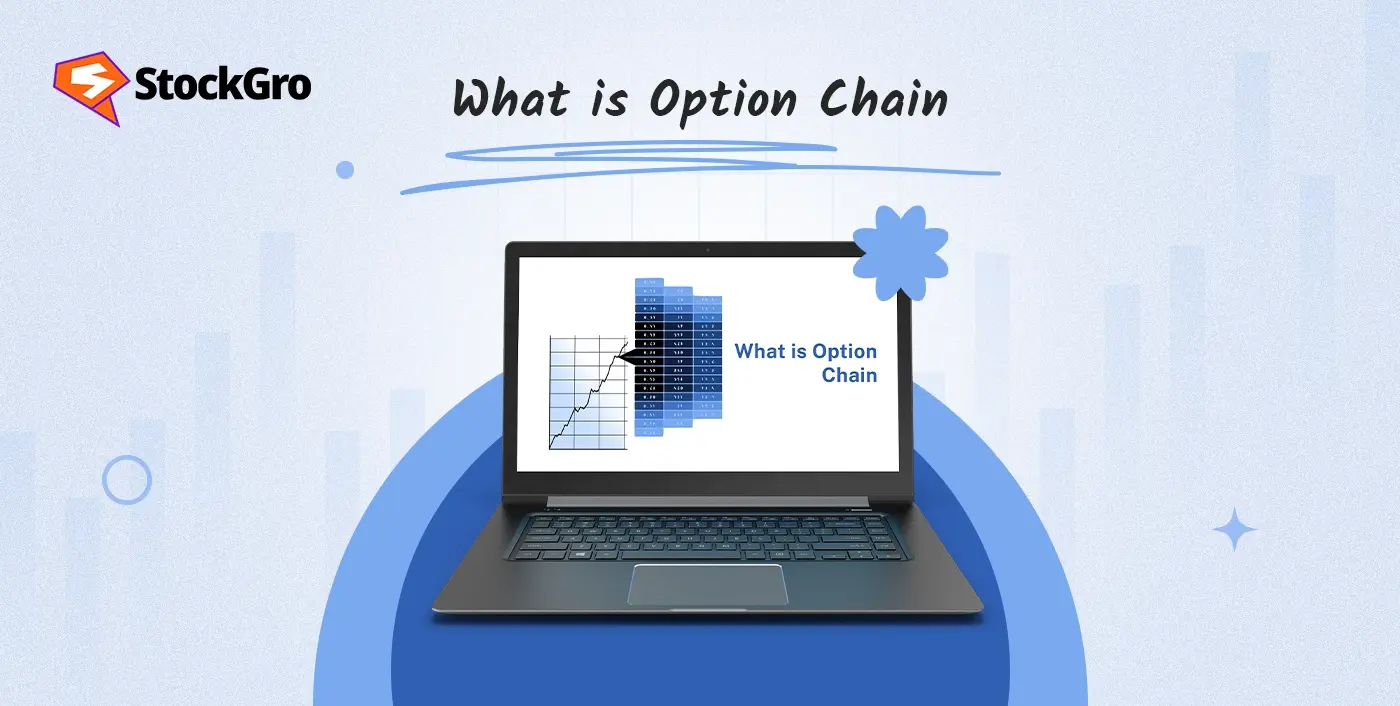
If you’re new to the world of derivative trading, you might have already heard the word “Option Chain”. It is basically an all-inclusive menu for all the options available of any given index or stock, having a list of strike prices, expiration dates, premiums, and other significant data. This blog helps you understand what is option chain, how to use these option chains is essential for anyone seeking an informed trading decision.
What is an Option Chain?
An option chain is a table which presents every accessible option contract for all stocks showing call, put, expiration date and strike prices. It sorts them out by their strike prices and expiry dates, giving traders a clear look at Call and Put options, along with their open interest, market value, volume and other trading info.
Option chains are easily accessible on most options trading platforms and are commonly used to evaluate market sentiment, probable price swings, and the instability of the underlying security.
Key Components of an Option Chain
Now that we know what is option chain, lets understand option chain’s elements that are essential for effective trading:
a. Call Options
Call options empower the buyer without pressurising them to buy an underlying asset at a particular strike price before it hits the expiry date. They are located on the left side of the table that contains option chains.
Investors apply call options with the hope of rise in the price of an underlying asset or stock.
b. Put Options
Put options empower the buyers without pressurising them to sell that underlying asset at a particular strike price before expiry. Right next to the option chain, you’ll see them.
Put options are used by traders who anticipate a decline in the value of an underlying asset. Similar to calls, their premium is influenced by multiple factors, including expiry date and instability.
c. Strike Price
A strike price is defined as the stable price for the option holder’s stock that needs to be paid for buying in the case of a Call option, or received for selling if you choose a Put option.
Strike prices are very important in defining where the option stands among at-the-money, in-the-money or out-of-the-money.
d. Expiry Date
Each option contract brings a specific date, known as an expiry date, which is the last day to use it. Option chains usually show contracts expiring at different timelines like weekly, monthly, or quarterly.
Shorter expiry options carry less time value with higher gamma, making them easily triggered by price swings.
e. Open Interest
Open interest is a measure of the total number of unresolved option contracts. It helps investors comprehend market participation at various strike prices.
Higher open interest levels at specific strike prices may indicate resistance areas or key support.
f. At the Money
An option is described as ATM or at-the-money when the strike price of the underlying asset is equal or almost similar to the current market price.
Their stable risk-reward structure makes them popular among investors.
g. In the Money
A call option is in-the-money or ITM with lower strike prices in comparison to the latest market price, whereas a put option is a better strike price than the same.
Due to their inherent profitability, ITM options are more expensive and have intrinsic value.
h. Out of the Money
OTM or out-of-the-money have zero intrinsic value, where the strike price is usually beyond the latest market price in case of call, and below in case of put.
OTM options are cheaper but riskier and commonly purchased while anticipating a significant price swing.
i. Bid and Ask Price
The asking price establishes the seller’s demands, but the bid price indicates what buyers are ready to pay for the option. A bid-ask spread indicates the dissimilarity between the two.
A tighter spread specifies higher liquidity, which is desirable for traders seeking a quick entry and exit position.
How to Read an Option Chain?
Here’s how you can read and interpret the option chain gradually:
1. Pick an Expiry Date
The initial step lies in picking an expiry date of your interest. This helps filter the option contract and only shows the valid ones till the expiry date. Temporary investors might opt for the nearest expiry date, while positional traders may look for the farthest.
2. Prioritise Strike Prices & Option Type
Each expiry date will show a list of strike prices and you’ll need to choose whether you’re analysing a call (expecting a price hike) or a put (expecting a price drop) option. Call options are displayed on the left and put on the right side.
3. Evaluate Bid & Ask Prices
A buyer’s bid is their maximum acceptable offer, whereas a seller’s ask is their minimum acceptable offer. A narrow bid-ask spread specifies good liquidity. Comparing them can help you determine how much premium you might receive or pay.
4. Validate Open Interest & Volume
OI or open interest shows the number of active contracts for that strike price, whereas volume reflects how many contracts were traded during the day. High OI and volume at a significant level specifies strong trader interest and potential support or resistance areas.
5. Recognise Option Moneyness (ITM, ATM, OTM)
- At-the-money is where the strike is almost near the updated market price of the asset.
- In-the-money options already have inherent value like a call with a strike below the market price.
- Out-of-the-money options lack that inherent value till now but might have them in future.
Knowing where your option stands helps you figure out the risks and potential value.
6. Apply the Combined Data for Insight
Now, combine all the above elements. A strike price with high volume and OI, a fair bid-ask spread and moneyness clarity can offer hints about the broader market expectations. Combine this with your chart assessment to schedule your entry or exit better.
How is Option Chain Data Useful for Traders?
Option chains offer instant market insight into what participants are anticipating, where a spike in OI at certain strike levels can be identified as resistance or support. Volume indicates trader activity and interest.
These insights help traders make smarter moves while betting on instability, direction, and time decay, keeping the probable risk in mind.
How to Analyse an Option Chain for Trading Decisions
For evaluation of an option chain:
- Find Open Interest clusters to spot significant price levels.
- Compare changes in OI and volume to analyse fresh positions.
- Track bid-ask spread to judge liquidity.
- Merge with technical evaluation to confirm trades.
This helps spot bearish or bullish sentiments, probably reversal zones, and potential breakouts or breakdowns.
Option Chain Example Explained
Imagine a stock is trading at ₹2,000. An option chain might list call and put options for strike prices ranging from ₹1,900 and ₹2,100.
- Here, the ATM has a strike price of ₹1,900.
- Calls below ₹1,900 are ITM and beyond are OTM.
- Puts beyond ₹1,900 are ITM and below are OTM.
- If the ₹1,900 strike call has high open interest, investors expect the stock price to stay close to it.
This quick information helps traders act on trends promptly.
Common Mistakes to Avoid When Using Option Chains
- Neglecting Liquidity to opt for illiquid trading options can cause slippage and poor exits.
- Over-dependency on OI can be risky as high OI doesn’t always indicate the upcoming price swings.
- Misreading ITM or OTM Status should be avoided and you must consider the latest market price before placing trades.
- Ignoring Expiry date can either increase time decay losses or reduce profitability.
Avoiding these can significantly boost your success rate in option chain analysis.
Option Chain Vs Option Greeks: What’s the Difference?
While an option chain delivers the fundamental trading data, Option Greeks offer in-depth insight into an option’s behaviour:
- We can measure price sensitivity with delta.
- Time decay is measured by theta.
- Vega measures sensitivity to instability.
- Gamma measures Delta’s changing rate.
If you want a more complete picture to make better decisions, combine option chain data with Greeks.
Tips for Beginners to Use Option Chains Effectively
- To understand how chains react to price swings, start by paper trading
- Prioritise ATM options for stable exposure.
- Apply open interest to spot strike prices.
- Avoid low-volume contracts if you’re not confident.
- Don’t neglect bid-ask spread; they directly affect your profitability.
- Always be ready with a spot-loss approach.
Learning the interpretation and action on option chains demand practice, but pays off in smarter trades.
Conclusion
An option chain is like a guide that helps investors understand prices, contract activity, and market sentiment. If you’re an intraday trader or hold investments for longer, knowing how to read and understand these chains can help you gain expertise. If you are well-versed with things like Open Interest, strike prices, Calls, Puts and know how to put all of these together with excellent trading strategies, it can really give you an edge in the market.
FAQs
To read an Option Chain on NSE, first choose the underlying stock or index, and then, select the expiry date. Your table will display strike prices in the middle, with Call options on the left side and Put options on the right. Prioritise valuable information like OI, volume, Last Traded Price, and Bid-Ask prices, and make smarter moves by understanding if the options are in-the-money, at-the-money, or out-of-the-money.
OI or Open Interest tells you how many excellent option contracts are available for a certain price and expiry date. It also shows liquidity and market participation. If OI goes up, it means new contracts are being added. If it goes down, it means people are closing their positions. High OI levels typically indicate significant support or resistance zones for traders. Analysing OI trends with price options can help you figure out the bullish or bearish sentiment within the market.
Traders check out option chains to understand market sentiments and the probability of price swings. High OI at certain strike prices may function as resistance or support levels. A sharp spike in Call OI could mean bearish sentiment, while high Put OI might indicate bullish expectations. By analysing these changes in OI, volume, and premiums, traders try to get where prices might lead to. Option chain analysis often goes hand-in-hand with technical indicators to support traders in planning entry, exit and stop-loss level more effectively.
Certainly. Option chains are best for intraday traders, who monitor fluctuations in OI, volume, and premium movement to keep pace with quick trends. Sudden fluctuations in Bid-Ask spread or spikes in OI could specify buying or selling pressure. Observing which strike prices are gaining maximum activity helps identify probable price ranges for the day. Traders also look for ATM strike price behaviour to understand sentiment shifts quickly. It’s most effective when combined with real-time technical charts.

